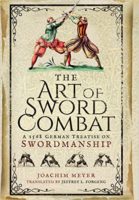New for this year is Dr Jeffry L. Forgeng's translation of the recently discovered Fechtbuch ‘The Art of Sword Combat’[1] by Joachim Meyer. This new offering is thought to pre-date Meyer’s famous work, ‘The Art of Combat’ (1570) by two years.
Dr Forgeng is well qualified to handle an original, old work. He’s done research on Meyers' work in the past, is an acknowledged authority in things medieval (Yes, I know Meyer is of the 'renaissance' period), and has been a prolific author of works from that time.
Well known, and recently honoured by the HEMA community, he is often quoted (usually related to his position as Curator with the Higgins Armory) by other scholars working in the historical swordplay discipline. The reader is in good and knowledgeable hands as he is guided to what this new (older actually) Meyer work means to the study of Meyer’s work, and to our discipline.
Dr Forgeng's approach to the book is to directly explore Meyers’ life, his works, the weapons he worked with, and, finally, the 1568 treatise.
We get an update to what is now known about Meyer. He started his professional life as a middle-class cutler in the Germanic part of the Holy Roman Empire. Then he drifted into conducting swordplay prizefights and learning swordplay, before dying young in 1570 as a fencing master newly appointed to a noble household. But like the rest of us, Dr Forgengs is unable to tell us from where Meyer learned his practical swordplay, though he does guide us through the many influences on Meyer’s first treatise.
‘The Art of Sword Combat’ is then introduced and described as the precursor to ‘Art of Combat’. Dr Forgeng does describe some major differences between the two works, and gives us his thoughts on the how and why Meyers thinking changed in the few years between the two publications. The doctor also makes the rather startling observation that the first of the two works is actually more clear in describing technique than the follow-on. There are significant differences in the presentation of both dusack and rapier work as well.
By Meyers time, armoured sword fighting on foot as a combat art was obsolete. The time of the partially armoured Landsknecht and two handed swords had just passed. The longsword was a flexible ‘sporting weapon’, the use of which was not restricted to thrusts and cuts. It could be wielded to inflict ‘slinging hits’.
Being German he explains the sporting dusak, and introduces the dueling rapier. The latter was only a recent introduction to the German armory, and Meyers assessment of this ‘foreign weapon’ and its use did change between his two books.
The core of this book is Dr Forgeng’s interpretation of the new text; offering us detailed translations of ‘The Art ...’, supported with 28 clear and richly rendered illustrations. I’m not an expert on Meyers work nor the period technique of the ‘Old Squinting Cut’ (Wait! There’s a 'new' one?), but I can assure you that Forgeng's translations read easily.
I very much appreciated the glossary included in this book.
“When I use a word,” Humpty Dumpty said, in rather a scornful tone, “it means just what I choose it to mean—neither more nor less.”[2]
In my modest on-line HEMA researches, I’ve noticed a lot of discussion about not only what was meant by the description of the medieval maneuver at hand, but as often, there is a lot of debate about what the old German words actually mean. The advantage of a detailed glossary is, notwithstanding debate in the community, the author is using ‘this’ definition for his description or assessment of a plate or passage in 'this' work. This in turn gives us a common frame of reference to discuss in current context, this one work on its' own.
‘The Art of Sword Combat’ is for me a clear and succinct presentation of 'new' work in a beautifully put-together book. And is well worth the time and shelf space of any HEMA enthusiast. For the Meyer-scholar, this is your Christmas gift hint to your family.
Work Cited
1. Meyer, Joachim (Forgeng, Dr J.L. transl) The Art of Sword Combat. Barnsley, UK: Frontline Books. 2016
2. Lewis Carroll (Dodgson, Charles L.), Through the Looking-Glass, 1872
And for those of you interested in the subject of fight books and their restoration, I recommend you to this site.
